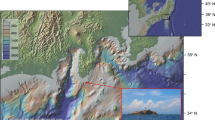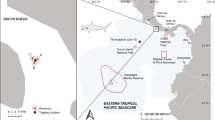Abstract
Marine top predators are common at offshore bathymetric features such as islands, atolls, and seamounts, where most pelagic reef fish reside, while certain sharks perform inter-island movements between these formations. Scalloped hammerhead sharks are known to school in great numbers at small islands and seamounts in the eastern tropical Pacific (ETP) and are very susceptible to fisheries while moving into the open sea. It is, therefore, essential to understand hammerhead inter-island movements and environmental effects to provide baseline information for their conservation and management within and beyond an insular marine protected area. Movements of scalloped hammerheads were analyzed in the Galapagos Marine Reserve (GMR) and ETP, and environmental factors were linked to their movements. Hammerheads were tagged (N = 134) with V16 coded pingers (July 2006 to July 2010) in the northern Galapagos and detected at listening stations around four islands in the GMR and two isolated islands in the ETP, 700 and 1,200 km away. Hammerheads formed daytime schools at specific locations, but dispersed at night. Overall, more daytime than nighttime detections were recorded at all receivers in the northern Galapagos Islands, and more detections in the up-current sides of these islands. Hammerheads remained more days at the northern islands during part of the warm season (December–February) compared to the cool; however, fewer individuals were present in March–June. Movement modes were diel island excursions (24-h cycles) in the northern Galapagos and inter-island in the GMR and ETP at different scales: (1) short back-and-forth (<50 km, SBF), <5 days cycles, (2) medium distance (50–300 km, MDT), 5–20 days, and (3) long distance (>300 km, LDT), 15–52 days. The high degree of inter-island connectivity of hammerheads within the northern GMR is striking compared to the almost nil movement to the central GMR. A seasonal migratory pattern to locations offshore is indicated by (1) fewer hammerheads observed in the northern GMR during part of the warm season (March–June) and (2) evidence of LDT movements from the northern GMR to other islands in the ETP. LDT movements of mature female hammerheads are possibly associated with pupping areas. Our results indicate that currents, season, and individual behavior mainly drive inter-island movements of hammerheads at small (SBF) and medium (MDT) scales. These findings have important implications for the management of a highly mobile and endangered top predator within a marine protected area and beyond.








Similar content being viewed by others
References
Afonso P, Fontes J, Holland KN, Santos RS (2009) Multi-scale patterns of habitat use in a highly mobile reef fish, the white trevally Pseudocaranx dentex, and the implications for marine reserve design. Mar Ecol Prog Ser 381:273–286
Banks S (2002) Ambiente físico. In: Danulat E, Edgar GJ (eds) Reserva marina de Galápagos. Línea base de la biodiversidad. Fundación Charles Darwin/Parque Nacional Galápagos, Santa Cruz, Galápagos, pp 22–37
Bessudo S, Soler G, Klimley AP, Ketchum JT, Arauz R, Hearn A (2011) Residency of the scalloped hammerhead shark (Sphyrna lewini) at Malpelo Island and evidence of migration to other islands in the eastern tropical Pacific. Environ Biol Fishes 91:165–176
Bolden SK (2000) Long-distance movement of a Nassau grouper (Epinephelus striatus) to a spawning aggregation in the central Bahamas. Fish Bull 98:642–645
Bonfil R, Meyer M, Scholl MC, Johnson R, O’Brien S, Oosthuizen H, Swanson S, Kotze D, Paterson M (2005) Transoceanic migration, spatial dynamics, and population linkages of white sharks. Science 310:100–103
Castañeda-Suárez JD, Sandoval-Londoño LJ (2007) Hábitos alimentarios del tiburón martillo, Sphyrna lewini (Griffith & Smith, 1834) en el Pacífico Ecuatoriano. In: Martínez-Ortiz J, Galvan-Magana F (eds) Tiburones en el Ecuador: casos de estudio. EPESPO-PMRC, Manta, pp 66–76
Castro JI (1983) The sharks of North American waters. Texas A&M University Press, College Station
Compagno LJV, Dando M, Fowler S (2005) Sharks of the world. Princeton Field Guides. Princeton University Press, Princeton
Dewar H, Mous P, Domeier M, Muljadi A, Pet J, Whitty J (2008) Movements and site fidelity of the giant manta ray, Manta birostris, in the Komodo Marine Park, Indonesia. Mar Biol 155:121–133
Gero S, Gordon J, Carlson C, Evans P, Whitehead H (2007) Population estimate and inter-island movement of sperm whales, Physeter macrocephalus, in the Eastern Caribbean Sea. J Cetacean Res Manag 9:143–150
Graham RT, Roberts CM, Smart JCR (2006) Diving behaviour of whale sharks in relation to a predictable food pulse. J R Soc Interface 3:109–116
Hamilton WJ, Watt KE (1970) Refuging. In: Johnston RF, Frank PW, Michener CD (eds) Annu Rev Ecol Syst 1:263–287
Harvey E, Fletcher D, Shortis M (2002) Estimation of reef fish length by divers and by stereo-video. A first comparison of the accuracy and precision in the field on living fish under operational conditions. Fish Res 57:257–267
Hearn A, Ketchum JT, Klimley AP, Espinoza E, Peñaherrera C (2010) Hotspots within hotspots? Hammerhead shark movements around Wolf Island, Galapagos Marine Reserve. Mar Biol 157:1899–1915
Heithaus MR, Dill LM, Marshall GJ, Buhleier B (2002) Habitat use and foraging behavior of tiger sharks (Galeocerdo cuvier) in a seagrass ecosystem. Mar Biol 140:237–248
Holland KN, Lowe CG, Wetherbee BM (1996) Movement and dispersal patterns of the blue trevally (Caranx melampygus) in a fisheries conservation zone. Fish Res 25:279–292
Homma K, Maruyama T, Itoh T, Ishihara H, Uchida S (1997) Biology of the manta ray, Manta birostris, Walbaum, in the Indo-Pacific. In: Séret B, Sire JY (eds) Proceedings of the 5th Indo-Pacific fish conference, Noumea. Soc Fr Ichthyol, Paris, pp 209–216
Houvenaghel GT (1984) Oceanographic setting of the Galápagos Islands. In: Perry R (ed) Galapagos (key environments). Pergamont Press, Oxford, pp 43–54
Hulbert LB, Aires-da-Silva AM, Gallucci VF, Rice JS (2005) Seasonal foraging movements and migratory patterns of female Lamma ditropis tagged in Prince William Sound, Alaska. J Fish Biol 67:490–509
Karpov K, Kogut NJ, Geibel JJ (2009) Estimating fish length from vertical morphometric parameters. Calif Fish Game 95:161–174
Ketchum JT (2011) Movement patterns and habitat use of scalloped hammerhead sharks (Sphyrna lewini) in the Galapagos Islands: implications for the design of marine reserves. Ph.D. dissertation, University of California, Davis
Ketchum JT, Hearn A, Shillinger G, Espinoza E, Peñaherrera C, Klimley AP (2009) Shark movements and the design of protected pelagic environments within and beyond the Galapagos Marine Reserve. In: Wolff M, Gardener M (eds) Proceedings of the Galapagos science symposium 2009. Charles Darwin Foundation, Puerto Ayora, Galapagos, Ecuador, pp 127–130
Ketchum JT, Hearn A, Klimley AP, Espinoza E, Peñaherrera C, Largier JL (2014) Seasonal changes in movements and habitat preferences of the scalloped hammerhead shark (Sphyrna lewini) while refuging near an oceanic island. Mar Biol. doi:10.1007/s00227-013-2375-5
Klimley AP (1987) The determinants of sexual segregation in the scalloped hammerhead shark, Sphyrna lewini. Environ Biol Fishes 18:27–40
Klimley AP, Anderson S (1996) Residency patterns of white sharks at the South Farallon Islands, California. In: Klimley AP, Ainly DG (eds) Great white sharks, the biology of Carcharodon carcharias. Academic Press, San Diego, pp 365–373
Klimley AP, Butler SB (1988) Immigration and emigration of a pelagic fish assemblage to seamounts in the Gulf of California related to water mass movements using satellite imagery. Mar Ecol Prog Ser 49:11–20
Klimley AP, Nelson DR (1984) Diel movement patterns of the scalloped hammerhead shark (Sphyrna lewini) in relation to El Bajo Espiritu Santo: a refuging central position social system. Behav Ecol Sociobiol 15:45–54
Klimley AP, Butler SB, Nelson DR, Stull AT (1988) Diel movements of scalloped hammerhead sharks (Sphyrna lewini) to and from a seamount in the Gulf of California. J Fish Biol 33:751–761
Meyer CG, Holland KN (2005) Movement patterns, home range size and habitat utlilization of the bluespine unicornfish, Naso unicornis (Acanthuridae) in a Hawaiian marine reserve. Environ Biol Fishes 134:602–606
Meyer CG, Holland KN, Papastamatiou YP (2007a) Seasonal and diel movements of giant trevally Caranx ignobilis at remote Hawaiian atolls: implications for the design of Marine Protected Areas. Mar Ecol Prog Ser 333:13–25
Meyer CG, Papastamatiou YP, Holland KN (2007b) Seasonal, diel, and tidal movements of green jobfish (Aprion virescens, Lutjanidae) at remote Hawaiian atolls: implications for marine protected area design. Mar Biol 151:2133–2143
Meyer CG, Clark TB, Papastamatiou YP, Whitney NM, Holland KN (2009) Long-term movement patterns of tiger sharks Galeocerdo cuvier in Hawaii. Mar Ecol Prog Ser 381:223–235
Morato T, Varkey DA, Damaso C, Machete M, Santos M, Prieto R, Santos RS, Pitcher TJ (2008) Evidence of a seamount effect on aggregating visitors. Mar Ecol Prog Ser 357:23–32
Musyl MK, Brill RW, Boggs CH, Curran DS, Kazama TK, Seki MP (2003) Vertical movements of bigeye tuna (Thunnus obesus) associated with islands, buoys, and seamounts near the main Hawaiian Islands from archival tagging data. Fish Oceanogr 12:152–169
Nance HA, Klimley AP, Galván-Magaña F, Martínez-Ortiz J, Marko PB (2011) Demographic processes underlying subtle patterns of population structure in the scalloped hammerhead shark, Sphyrna lewini. PLoS One 6:e21459
Palacios DM (2004) Seasonal patterns of sea-surface temperature and ocean color around the Galapagos: regional and local influences. Deep Sea Res Part II 51:43–57
Papastamatiou YP, Meyer CG, Carvalho F, Dale JJ, Hutchinson MR, Holland KN (2013) Telemetry and random walk models reveal complex patterns of partial migration in a large marine predator. Ecology 94:2595–2606
Pikitch EK, Camhi MD, Babcock E (2008) Introduction to sharks of the open ocean. In: Camhi MD, Pikitch EK, Babcock E (eds) Sharks of the open ocean. Biology, fisheries and conservation. Blackwell Publishing, Oxford, pp 3–13
Torrence C, Compo GP (1998) A practical guide to wavelet analysis. B Am Meteorol Soc 79:61–78
Wiens JA (1976) Population responses to patchy environments. Annu Rev Ecol Syst 7:81–120
Worm B, Lotze HK, Myers RA (2003) Predator diversity hotspots in the blue ocean. Procc Natl Acad Sci 100:9884–9888
Acknowledgments
We thank the Galapagos National Park and the Charles Darwin Foundation for supporting this project since its inception in 2006 and the captains and crews of the M/N Sierra Negra and M/N Guadalupe River, and Cap. T. Franco provided crucial support for the deployment and maintenance of the array of receivers throughout the GMR. Special thanks to the staff of the Biomar Laboratory of the Charles Darwin Research Station, in particular, M. Wolff, R. Pépolas, J. Delgado, S. Banks. We are indebted to the GNP personnel who assisted in the different phases of this project, especially Cap. P. Moncayo and Cap. O. García and their crews for their invaluable help in the placement of receivers and tagging of sharks. Many thanks to the CDF and GNP volunteers who assisted in fieldwork. Special thanks to all the professional taggers who helped tag almost 150 hammerhead sharks during the course of this study: A. Vázquez, G. Tomalá, G. Vázquez, G. Soler, F. Buyle, R. Pépolas, J. Delgado and P. Zarate. We thank E. Melcon and A. Gottlieb for their assistance on statistical analyses, and K. Kumli for reviewing this manuscript. We would also like to thank the Associate Editor and three anonymous reviewers for their constructive comments and suggestions that greatly improved this manuscript. This work was funded by Conservation International, WWF-Galapagos, Galapagos Conservation Trust, Galapagos Conservancy, Lindblad Expeditions, Oak Foundation, National Geographic, AeroGal, Parques Nacionales Naturales de Colombia, Fondo para la Acción Ambiental y la Niñez, Whitley Fund for Nature. JTK was awarded a UC MEXUS-CONACYT fellowship that supported his doctoral studies at UC Davis and part of this work. Thanks to K. Busto for the editing of figures.
Author information
Authors and Affiliations
Corresponding author
Additional information
Communicated by J. D. R. Houghton.
Electronic supplementary material
Below is the link to the electronic supplementary material.
Rights and permissions
About this article
Cite this article
Ketchum, J.T., Hearn, A., Klimley, A.P. et al. Inter-island movements of scalloped hammerhead sharks (Sphyrna lewini) and seasonal connectivity in a marine protected area of the eastern tropical Pacific. Mar Biol 161, 939–951 (2014). https://doi.org/10.1007/s00227-014-2393-y
Received:
Accepted:
Published:
Issue Date:
DOI: https://doi.org/10.1007/s00227-014-2393-y




